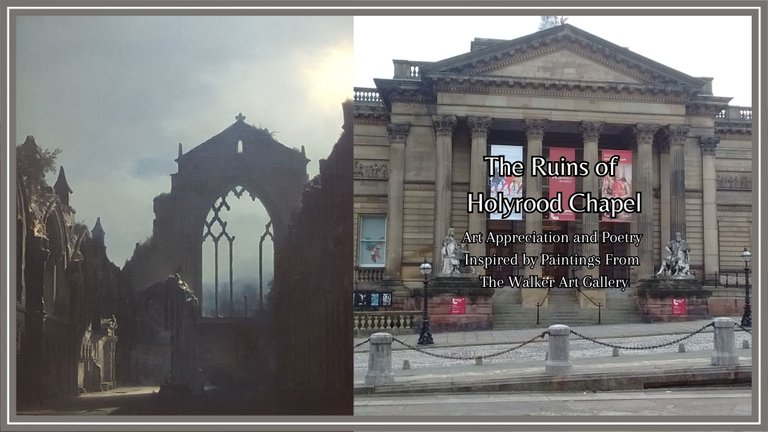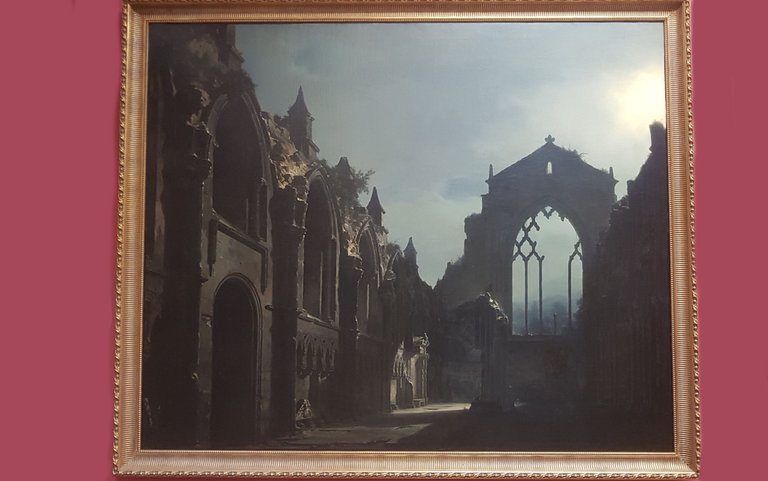The Walker Art Gallery, Liverpool - The Ruins of Holyrood Chapel - Art and Haiku #1

Silken moonbeams drape
bones of the Maelstrom's wreckage -
housing noble ghosts.
The Ruins of Holyrood Chapel
In the early 19th century, Continental artists and writers were fascinated with the history of Scotland, mainly inspired by Sir Walter Scott's novels such as Ivanhoe written in 1819 and Rob Roy in 1817.
French artist Louis Daguerre, who trained as a stage designer in Paris, specialised in painting dioramas depicting realistic scenes viewed through an aperture allowing him to express light to create different weather effects.
The Ruins of Holyrood Chapel combines a diorama's illusionism and theatricality with the moonlit ruins' Romanticism.
The way this painting deals with light helped inspire Daguerre's later pioneering work in photography as he invented the daguerreotype process.
History of Holyrood Chapel
According to legend, Holyrood Abbey was founded as an Augustinian monastery by King David I in 1128. The abbey's symbol was a stag with its horns framing a cross since that was the vision King David I saw when attacked by a stag in the area.
The abbey was later chosen as the residence of the Scottish royalty because of the beauty of the surrounding hills and the parkland around it.
In 1501 James IV (1488-1513) cleared the ground of the abbey and built a palace for himself and his bride Margaret Tudor (sister of Henry the VIII). Further alterations were made by his successor James V (1513-1542).
In the 18th century, following the reunion of parliaments, the palace began to be neglected in favour of Scotland's castles. It became a sanctuary for poor and distressed noblemen. Royalty returned to the palace with Prince Charles Edward Stuart and the Duke of Cumberland. In 1768 the roof of the Abbey church collapsed, leaving the royal chapel in ruins.
Source: liverpoolmuseums.org.uk

The Walker Art Gallery
I recently visited the Walker Art Gallery with my girlfriend. During the three hours we spent there I took many pictures and wrote Haiku poems inspired by the art that had grabbed my attention.
Art galleries have a strange effect on me. I always find myself drawn into a meditative place by the quiet of the gallery and the impact of the art.
I am always this way in any gallery... names don't impress me. I could walk past a Picasso (although I do like Picasso) to sit and write in response to an unknown artist's work if it caught my eye and senses. I find it hard to explain, but it is like a force that draws me to certain paintings.
Although I was drawn to some of the world-famous works that the gallery holds, such as the Pre Raphelite, 'Echo and Narcissus' by John William Waterhouse, my eye was first drawn to The Ruins of Holyrood Chapel, pictured above.
Thanks for reading 🙂🌿

To read more about the aesthetics of true haiku, and the difference between haiku and senryu, please check out my post: Haiku Vs Senryu - The Aesthetics of Form
All images in this post are my own property, taken at The Walker Art Gallery.
Camera used - Samsung S7 Smartphone
If you have enjoyed this Haiku, please check out my homepage @raj808 for similar content.
I would like to give a big shout-out to @stickupcurator (and @stickupboys) for their amazing contribution to supporting music, art, imaginative writing, and all things creative on hive. If you haven't already, you should go check out their account for music, crypto podcasts and much much more 🙂👍
If you have enjoyed this post you can check out my other work on my homepage @raj808.





Didn't know it was a painting before I opened the post 🤣
It looks so realistic...
Yeah, it is pretty good painting by French artist Louis Daguerre.
it is one of my fav painting in the walker art gallery 🎨🙂